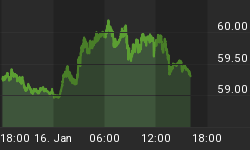U.S. equities were slammed on the first two trading sessions of the week after President Trump, seemingly out of the blue, took to Twitter and threatened to dramatically escalate China tariffs. On Sunday morning, Trump threatened to ratchet up current tariffs on Chinese goods from 10 percent to 25 percent before adding on Monday morning that another $325 billion worth of goods from the country could face a similar fate.
Trump’s tweets were initially seen as a means to extract more concessions from Beijing amidst reports that China had gone back on some of its earlier pledges agreed on during the ongoing trade talks. Nevertheless, they proved more than enough to rattle the markets.
The broad market benchmark, the S&P 500, fell more than two percent while the Dow Jones plunged nearly 700 points before managing to pare back some losses on Wednesday’s session.
Meanwhile, the Shanghai Composite Index has continued to lose ground, cratering six percent while the Stoxx Europe 600 Index has slipped about one percent;
Gold and silver hardly budged, moving less than half a percentage point while oil futures dropped to their lowest level in a month before recovering.
For those who thought Trump was only bluffing, make no mistake about it: Washington has just filed plans to hike tariffs on Chinese exports to the U.S. worth $200 billion to 25 percent from 10 percent effective from 12:01 a.m. Eastern time Friday.
S&P 500 vs. Dow Jones 3-Day Returns

Source: CNN Money

No more concessions
As widely expected, Beijing quickly returned fire by broadcasting its intention to continue playing hardball.
On Tuesday, Chinese state media came out with reports that warned the U.S. against starting another trade war by asking for more concessions.
According to Shanghai-based political analyst Chen Daoyi, China has the will and power to stand its ground and is unlikely to give in to Washington’s demands. He also added that the Politburo—China’s top decision-making body—had changed its stance within the last two months and has decided to devote less attention to the country’s economic situation.
Related: Morgan Stanley To Exit Russia As Sanctions Bite
According to visiting professor with Johns Hopkins University Simon Evenett and his counterpart from Peterson Institute for International Economics Gary Hufbauer: “…seen from Beijing’s viewpoint, the downside from a failed deal and higher US tariffs is diminished now that Chinese stimulus plans are in place.”
The fact that Trump’s polemic has coincided with an important national event has probably not helped matters much. This year marks the centenary of the May Fourth Movement when the country staged a series of protests against Western imperialism in the aftermath of WW1 as well as the 30th anniversary of the Tiananmen Square protests.
What the experts at home are saying
Back in the U.S., there seems to be consensus that Trump’s threats are likely to have far-reaching repercussions though with varying outcomes.
Reuters cites Nomura as saying that the two protagonists are unlikely to back down from their negotiating positions though the analysts say there’s now little chance of the two countries will strike a comprehensive trade deal this week. The bank sees a 45 percent chance the newly announced tariffs will go into effect on Friday as planned but negotiations will continue thereafter and a 40 percent chance the U.S. will postpone the tariffs and talks will continue.
Others are bracing for harder times, with top investment banks laying out worst case scenarios if the tariffs take effect as feared. "Fasten your seatbelt and don't hold your breath," Bank of America strategists warned in a note this week, as reported by BusinessInsider.
Global equities have remained on edge since those tweets. Yet, things could quickly take the southern route, with U.S. and Chinese equity markets likely to bear the full brunt of a fallout. According to the experts, Apple, Boeing and Caterpillar are likely to be hardest hit in such a scenario—they are all trading lower ~5 percent this week.

Source: CNBC
For all the bluster and political brinkmanship, China’s economy is likely to fare far worse in the event of a full-blown trade war, with the country’s GDP taking a hit of 1.2-1.5 percent.
If those estimates look a tad harsh, consider that the latest data coming from China that shows that exports contracted 2.7 percent in April, well below estimates of 3 percent growth.
In contrast, retaliatory tariffs by the Middle Kingdom are only expected to nick off 0.1 percent from U.S.’ GDP growth.
By Alex Kimani for SafeHaven.com
More Top Reads From Safehaven.com:

















